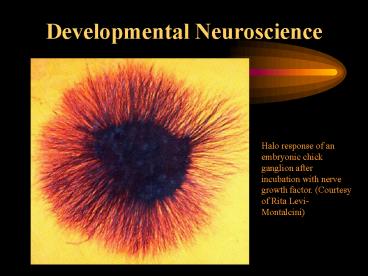Developmental Neuroscience - PowerPoint PPT Presentation
1 / 28
Title:
Developmental Neuroscience
Description:
Halo response of an embryonic chick ganglion after incubation with nerve growth factor. ... Lateral view of the human brain shown at one-third size at several ... – PowerPoint PPT presentation
Number of Views:131
Avg rating:3.0/5.0
Title: Developmental Neuroscience
1
Developmental Neuroscience
Halo response of an embryonic chick ganglion
after incubation with nerve growth factor.
(Courtesy of Rita Levi-Montalcini)
2
Embryonic and Fetal Development of the Human Brain
Actual Size
Actual Size
3
Photographs of Human Fetal Brain Development
Lateral view of the human brain shown at
one-third size at several stages of fetal
development. Note the gradual emergence of gyri
and sulci.
4
Nervous System Development in the Human Embryo
(a) At 18 days after conception the embryo begins
to implant in the uterine wall. It consists of 3
layers of cells endoderm, mesoderm, and
ectoderm. Thickening of the ectoderm leads to the
development of the neural plate (inserts). (b)
The neural groove begins to develop at 20 days.
5
Nervous System Development in the Human Embryo
(c) At 22 days the neural groove closes along the
length of the embryo making a tube. (d) A few
days later 4 major divisions of the brain are
observable the telencephalon, diencephalon,
mesencephalon, and rhombencephalon.
6
Eight Phases in Embryonic and Fetal Development
at a Cellular Level
- Mitosis/Proliferation
- Migration
- Differentiation
- Aggregation
- Synaptogenesis
- Neuron Death
- Synapse Rearrangement
- Myelination
8 stages are sequential for a given neuron, but
all are occurring simultaneously throughout fetal
development
7
Eight Phases in Embryonic and Fetal Development
at a Cellular Level
1. Mitosis 2. Migration 3.
Aggregation and
4. Differentiation
5. Synaptogenesis 6. Death 7. Rearrangement
8. Myelination
8
1. Mitosis/Proliferation
- Occurs in ventricular zone
- Rate can be 250,000/min
- After mitosis daughter cells become fixed post
mitotic
9
1. Mitosis/Proliferation
Neurons and Glia
At early stages, a stem cell generates
neuroblasts. Later, it undergoes a specific
asymmetric division (the switch point) at which
it changes from making neurons to making glia
10
2. Migration
Note that differentiation is going on as neurons
migrate.
11
2. Migration
Radial Glia
Radial glial cells act as guide wires for the
migration of neurons
12
2. Migration
Growth cones crawl forward as they elaborate the
axons training behind them. Their extension is
controlled by cues in their outside environment
that ultimately direct them toward their
appropriate targets.
Growth Cones
The fine threadlike extensions shown in red and
green are filopodia, which find adhesive surfaces
and pull the growth cone and therefore the
growing axon to the right.
13
2. Migration
Growth Cones
Scanning electron micrograph of a growth cone in
culture. On a flat surface growth cones are very
thin. They have numerous filopodia
Ramon y Cajal drew these growth cones showing
their variable morphology
14
2. Migration How Do Neurons Know Where to Go?
There are extrinsic and intrinsic determinants of
neurons fate.
- Extrinsic signals
- Different sources of extrinsic signals
- Generic signal transduction pathway
- Intrinsic determinants
15
3. Differentiation
- Neurons become fixed post mitotic and specialized
- They develop processes (axons and dendrites)
- They develop NT-making ability
- They develop electrical conduction
16
3. Differentiation
Development of the cerebral cortex
The ventricular zone (VZ) contains progenitors of
neurons and glia. 1st neurons establish the
preplate (PP) their axons an ingrowing axons
from the thalamus establish the intermediate zone
(IZ). Later generated neurons establish layers
II-VI. After migration and differentiation there
are 6 cortical layers.
17
4. Aggregation
Like neurons move together and form layers
18
5. Synaptogenesis
Axons (with growth cones on end) form a synapse
with other neurons or tissue (e.g. muscle)
19
5. Synaptogenesis Attraction to Target Cells
Target cells release a chemical that creates a
gradient (dots) around them. Growth cones orient
to and follow the gradient to the cells. The
extensions visible in c are growing out of a
sensory ganglion (left) toward their normal
target tissue. The chemorepellent protein Slit
(red) in an embryo of the fruit fly repels most
axons.
20
6. Neuron Death
- Between 40 and 75 percent of all neurons born in
embryonic and fetal development do not survive. - They fail to make optimal synapses.
21
Neuron Death Leads to Synapse Rearrangement
Release and uptake of neurotrophic factors
Neurons receiving insufficient neurotropic factor
die
Axonal processes complete for limited
neurotrophic factor
22
7. Synapse Rearrangement
- Active synapses likely take up neurotrophic
factor that maintains the synapse - Inactive synapses get too little trophic factor
to remain stable
23
7. Synapse Rearrangement
Time-lapse imaging of synapse elimination
Two neuromuscular junctions (NM1 and NMJ2) were
viewed in vivo on postnatal days 7, 8, and 9.
24
8. Myelination
25
Myelination Lasts for up to 30 Years
26
Brain Weight During Development and Aging
27
Critical Periods
28
Teratogens
Greek teratos wonder or monster
genos - birth
- Physical agents (e.g., x-rays)
- Chemicals (e.g., drugs)
- Microorganisms (e.g., rubella)































